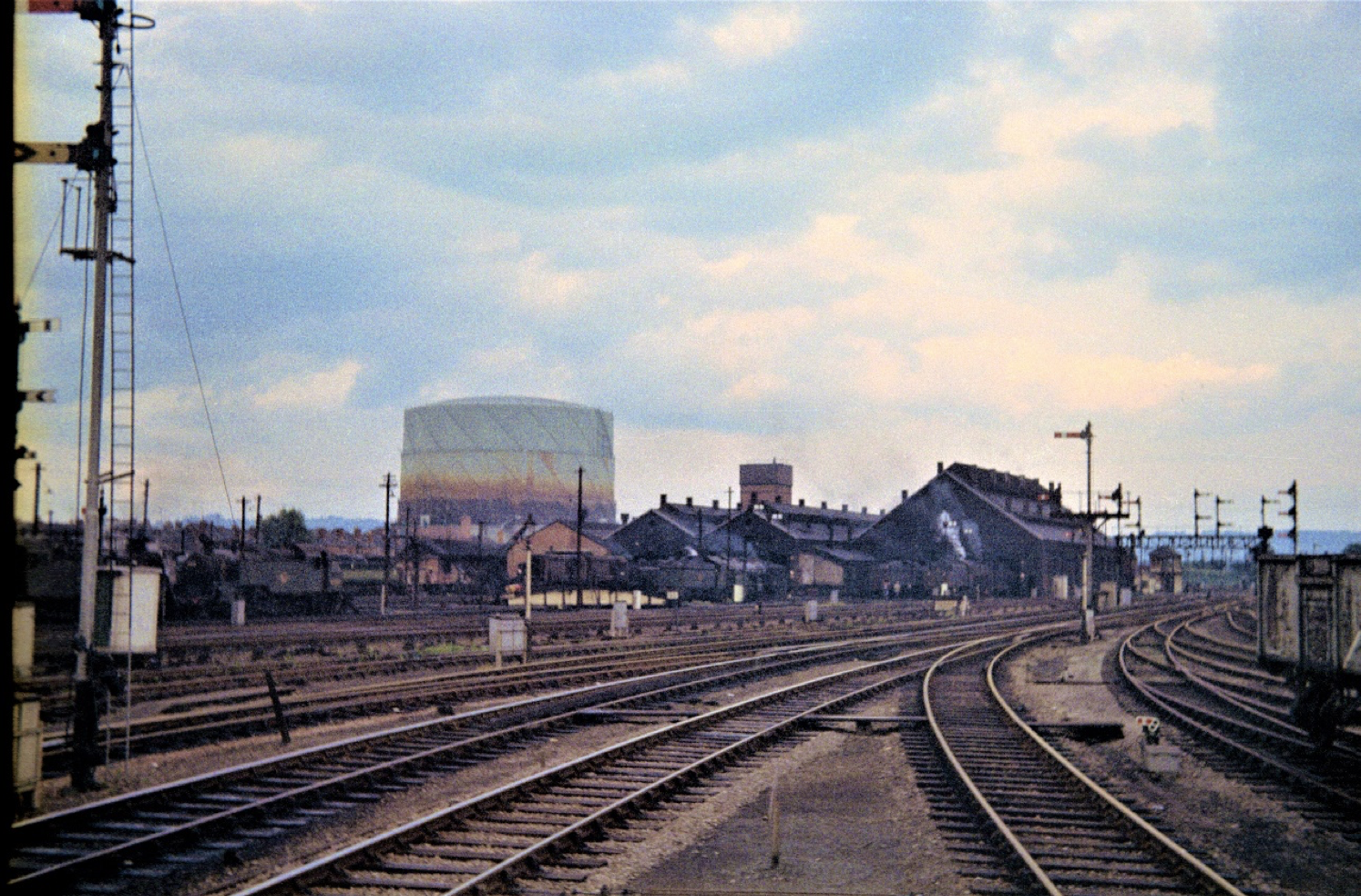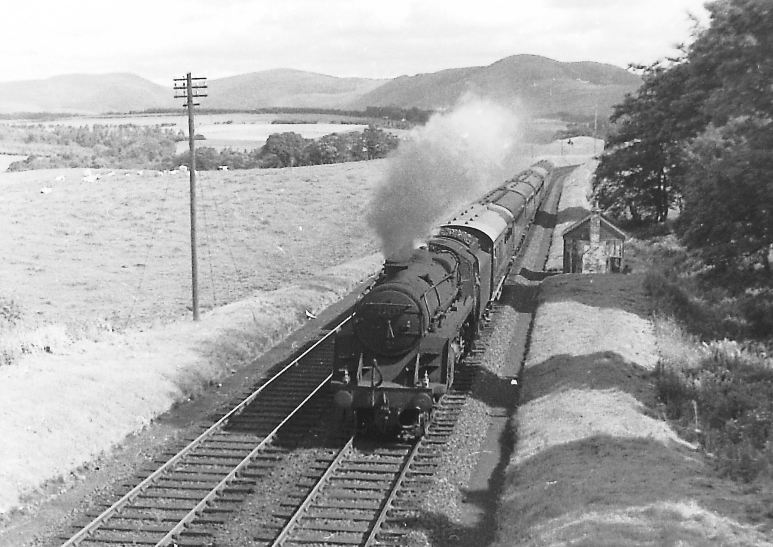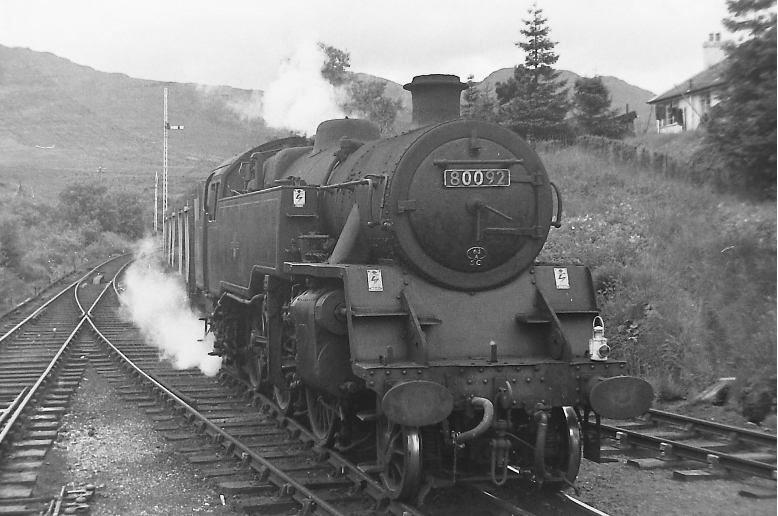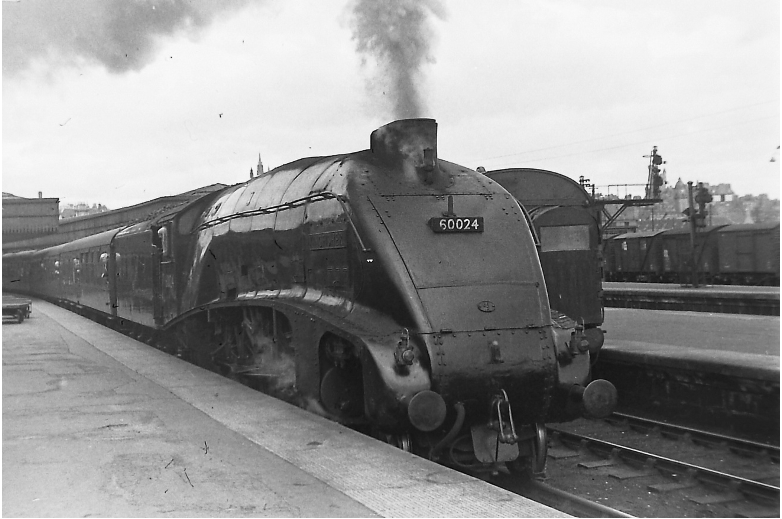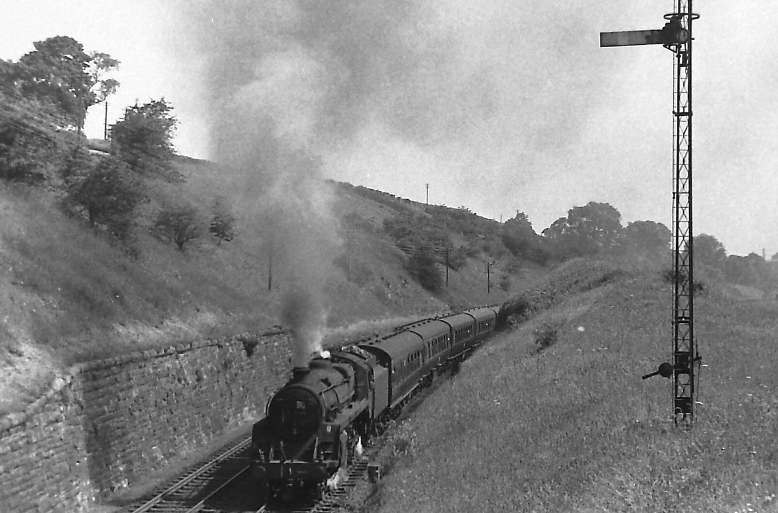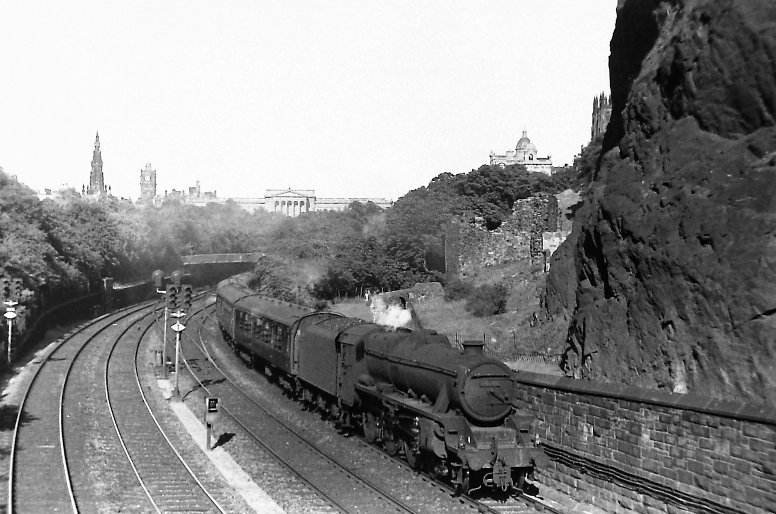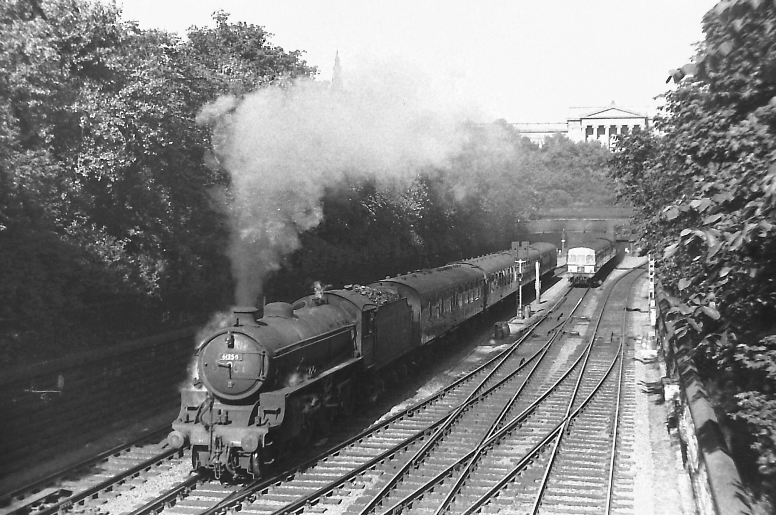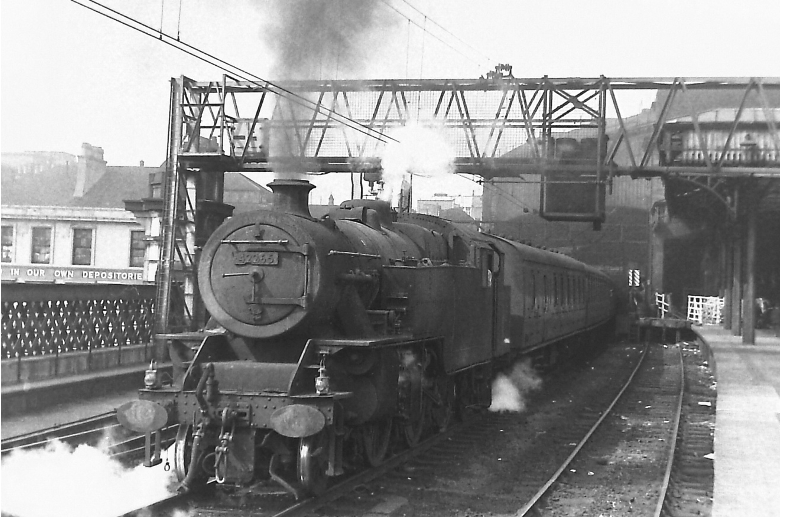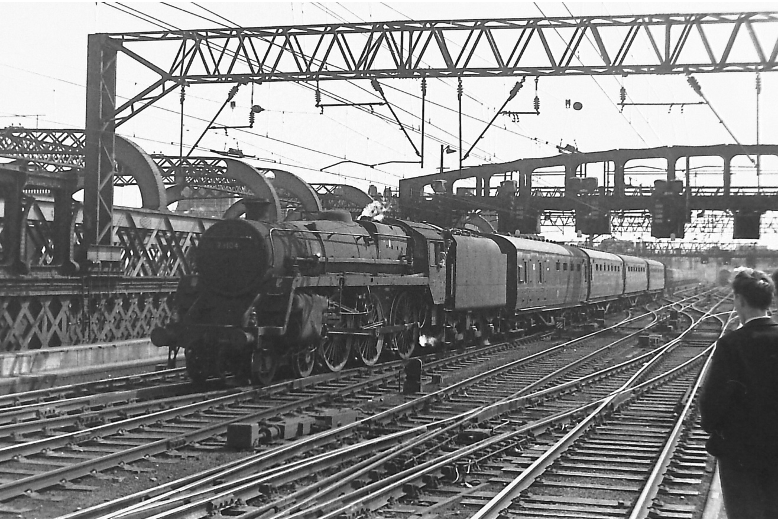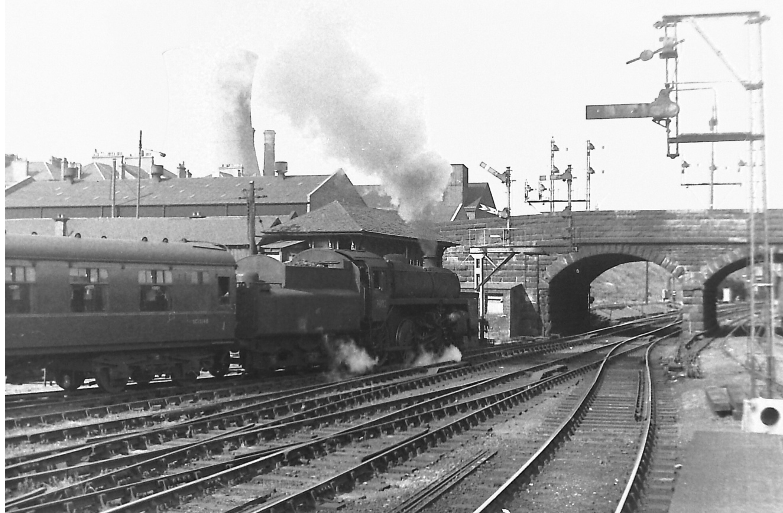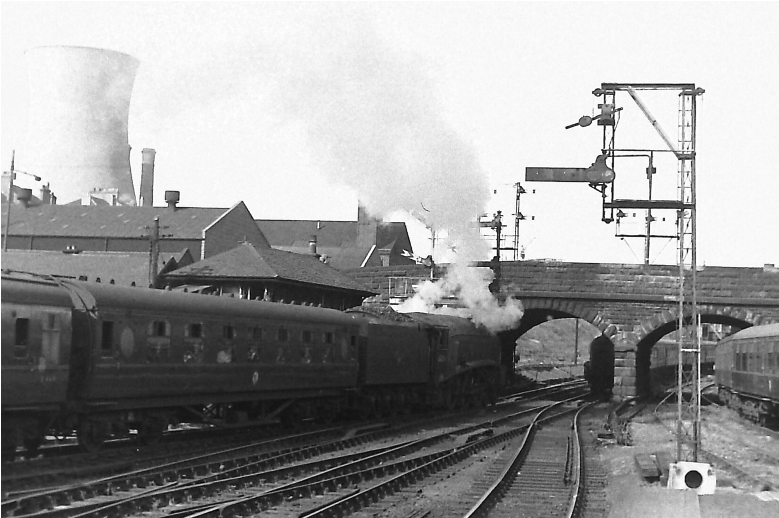Freedom of Scotland
1965
My second rail-roving week took place in July 1965, my main aim being to see as much steam as possible, as the end was near. I obtained from Scottish Railfans a slim volume that listed all the passenger trains that were still scheduled to be steam-hauled.
On this occasion I decided it would be more exciting to travel up by air, as recently I had had a first pleasure flight in a BEA helicopter at the Biggin Hill Air Show. Furthermore, cheap stand-by tickets had recently been introduced on BEA’s Heathrow – Glasgow service. I was living in Surbiton by this time, so my journey commenced uneventfully, when on Thursday 8 July I boarded the 12.44 285 bus in Kingston to London Airport Central, which was worked by RMs from Fulwell (FW) Garage. This route had been converted from trolleybuses as late as 1962 and extended to Heathrow. I had travelled this way before as part of a more mundane trip to Uxbridge, where I could catch a Black & White coach home to Gloucester.
It was not an interesting trip apart from crossing the SR Reading lines at Feltham. Although the yards were in use, there did not seem to be much steam activity, and the electrics were the ubiquitous 4-SUBs and antiquated 2-HALs. On arrival at Heathrow at about 13.30, I made my way to the European Terminal (now Terminal 1), for the 14.40 flight to Renfrew Airport. The aircraft was a BEA Vanguard G-APEM, and I was looking forward to my first trip aboard an airliner. We flew up over Coventry (visible through a hole in the cloud-sheet) and the Lake District whilst I was treated to afternoon tea on the hour-and-a-quarter flight. From the airport bus into Glasgow, I caught sight of my first Scottish locomotive on this trip, Standard ‘4’ 2-6-4T No. 80130 parked on the Clyde Bridge outside Central station. I had arranged to stay at the YMCA in Bothwell Street again, where a bath, bed and breakfast cost £1 per night. I also obtained from the Central station booking office my ‘Freedom of Scotland’ ticket for the princely sum of £6/10/0d.
On my first full day, Friday 9 July, I decided to try out the intensive steam-worked services from Central station, still worked by 2-6-4Ts of both Standard and Fairburn varieties. After leaving my bags at the luggage office, I left Glasgow Central on the 08.50 to Greenock, our eight-coach non-corridor train bowling along the four-track section to Paisley. After the trip following the south bank of the Clyde with views across to Dumbarton, I reached Greenock with its dock yards. Having returned to Paisley Gilmour St I then caught the 10.43, changing at Kilwinning for Ardrossan Winton Pier, where connections were made with the Caledonian Steam Packet Co. steamers to Arran. At Saltcoats, with its beach, sand dunes and golf course, there were good views across the Firth of Clyde to Arran, and down the coast towards Ayr and Ailsa Craig.
After lunch, I returned at 12.31 to St Enoch via Paisley Canal, mainly to check out Corkerhill depot again, which lay in the leafy south-western suburbs of Glasgow, as unlikely a location for a motive power depot as Bournemouth always seemed to be. On this occasion it did not seem to be giving much away though: those rare commodities for an Englishman, the 67A ‘Jubilees’ had been sent to the scrapheap at the end of 1962. I left St Enoch for Kilmarnock at 14.05 and, after depositing my bag at the station there, changed into the two-coach local train for Ayr departing at 16.13 hauled by another of the ubiquitous Standard ‘4’ 2-6-4Ts, No. 80111, a refugee from the GNS section.
The highlight of the day was to have been a trip on the ‘Port Road’. To my great regret, I was just too late to travel the direct line across Galloway from Dumfries, as it had been closed just a few weeks previously, on 14 June, and so I was unable to experience the delights of steam haulage on this line. However, it did mean that, for the foreseeable future, more trains were forced to use the toughly graded Stranraer – Girvan line to reach the south via Mauchline. In particular, the Newcastle and the heavily loaded ‘Northern Irishman’ boat trains were still steam hauled, hence my desire to make for Stranraer to return on one of the night boat trains. I caught the 18.09 from Ayr to Stranraer: the Glasgow services had long been operated by inter-city multiple units. True to form, the up ‘Northern Irishman’ was headed by the powerful combination of ‘Britannia’ 4-6-2 No. 70040 Clive of India (ex-ER) and ‘Black 5’ No. 45474.
However, I decided to take the lighter-loaded 22.00 Newcastle boat train as far as Carlisle which preceded the ‘Northern Irishman’, this time in the hands of a single ‘Black 5’ No. 45164. It was an enervating experience to sit near the front of the train and listen to the sharpening exhaust as the loco attacked the grades; then chattering away after cresting a summit on this switch-back route, accompanied by deft touches of the vacuum brake as we swung round the many curves. Once we joined the GSW main line at Mauchline, things quietened down somewhat, but we had a good run to Carlisle, arriving at 01.42 early on Saturday morning. This Saturday coincided with the Glasgow Fair holidays, and so there was plenty of activity even at two in the morning. The Newcastle boat train was taken over by No. D5105, one of the class allocated to Gateshead to work the Consett iron-ore freights, which was slightly disappointing: my hope for a Newcastle Pacific was forlorn.
Nevertheless, there were other interesting combinations: a train from Inverness came in behind No. D5367 and No. 45012, whilst the Euston – Oban train arrived behind No. 70034 Thomas Hardy. However, looking through my notes, it was noticeable that there was less variety in motive power, now being dominated by Stanier and Standard ‘class 5s’, with just a few ‘Britannias’ and a solitary ‘Clan’, No. 72008 Clan Macleod at the head of the up ‘Postal’. ‘Jubilees’ were few and far between, only 55A ones being seen including, at Dumfries later in the afternoon, No. 45660 Rooke heading a Birmingham – Leeds – St Enoch express. This ‘Jubilee’ had been a Bristol engine when we knew her in Gloucester.
On Saturday morning I made my way to the Nith valley for some photography in the area around picturesque Drumlanrig gorge, north of Thornhill. So, after watching the previous night’s activities, I retraced my steps along the GSW route aboard the 03.21 to Kilmarnock where I was united with my bag again. I then caught the 07.28 southbound stopping train to Thornhill (arr. 08.50), a sleepy little town in the Southern Uplands. I walked into town, and after a quick breakfast, caught a Western SMT bus (an Orion bodied Leyland PD3) working the long route from Dumfries to Glasgow, alighting at Carronbridge. I walked towards the site of the railway station to do some lineside photography. This was an ideal point from which to watch and photograph the Saturday procession of trains through Nithsdale. By lunchtime it was obvious that there was not a lot of variety to be seen, but I got shots of No. 73057 on the 10.20am Glasgow – London relief, and No. 45385 on a down fitted freight heading towards Durisdeer viaduct.
I returned to Thornhill to catch the 13.44 to Dumfries, and the 15.18 thence to Carlisle, arriving at 15.58. Here I managed to get a shot of ‘5XP’ No. 45573 Newfoundland, complete with diagonal yellow stripe banning it from working ‘under the wires’, waiting to work a southbound express over the Settle & Carlisle line. By now a sleepless night was catching up on me, so I took the northbound 16.08 to Perth, having arranged to stay at the Station Hotel, Stirling (cost £1/12/6d). On passing Kingmoor shed I noticed No. 46128 The Lovat Scouts stored outside, and a ‘V2’, No. 60846, presumably a refugee from the Waverley route as Carlisle Canal depot that served the route had now closed. With the train’s rhythm I was soon dozing fitfully, and so missed the most exciting part of the journey through the east end of Glasgow, where the adjuncts of the steam railway formed a natural part of the landscape.
Standard ‘5’ 4-6-0 No. 73057 heads south towards Carronbridge with a Glasgow Fair extra to London on 10 July 1965
What to do on Sundays had always been a bit of a problem, but by now I had accepted that one was not encouraged to travel on the Sabbath. So, on 11 July, I contented myself with a trip to Oban, spending the night there (cost £1/15/0d). The Highland lines had been dieselised since 1962, but this did not detract from the ever-changing vistas of Loch Etive, Connel Ferry Bridge, Glen Ogle, Kilchurn Castle set in Loch Awe, Ben Cruachan and Ben More overlooking Crianlarich.
On Monday 12 July I returned east aboard the 09.15 to Crianlarich, behind No. D5348 where, rather unexpectedly – as the Ballachulish branch had been dieselised – I came across the regular Killin branch engine, No. 80092 shunting timber wagons bound for the pulp mill at Corpach – a facility that had only opened in June. Oh, that I had come earlier, when the Caley 0-4-4Ts were still working! I then took the 12.07 West Highland line train north across barren Rannoch Moor to Fort William and Mallaig, enjoying on the last lap some of the most spectacular coastal scenery in the British Isles. Looking across the white sands of Morar, ranged the palisade of the north face of Eigg, Muck, Rhum and the other Small Isles, with the saw-tooth profile of the Black Cuillins stacking up behind the Sleat peninsula. Having crossed to Armadale on the connecting ferry, a MacBrayne Bedford coach in its distinctive red and green livery was waiting to take me to Broadford. I stayed with Mrs McInnes at ‘Isle View’, Harrapool, with a backdrop of the Red Cuillins, looking across the Sound of Raasay and the mainland of Knoydart with an airstrip in the foreground.
Standard ‘4’ 2-6-4T No. 80092 shunts timber wagons for the Corpach plant at the recently opened siding adjacent to Crianlarich Upper on 12 July 1965.
The next day I set off for Kyleakin aboard the 10.15 bus from Broadford to catch the 11.10 from Kyle of Lochalsh to Inverness, along the only line that equals the West Highland for dramatic scenery. In the first few miles, as the train twists and turns by the edge of Loch Carron through Duirnish and Plockton with its sub-tropical foliage at little more than 30 mph, that feeling of ‘other worldliness’ sets in. Contrast this with the climb over lonely moorland to Achnasheen, a crossing place on this long length of single line. This place acted as the railhead for a vast area of north-west Ross & Cromarty and Sutherland, including Gairloch and Ullapool. Apart from the station and hotel there was little else there, but two coaches were waiting to connect with the trains.
For the afternoon, I decided on a round trip from Inverness, at 14.30 to Elgin, changing to the 15.35 to Keith and Cairnie Junction, and the 17.23 onward, enabling me to traverse the Craigellachie – Aviemore branch, normally worked by a railbus. On this occasion the 18.45 was worked by a D5300 class diesel with one coach, an LMS BSK, the guard being equipped with a set of steps to enable passengers (of which there were few) to board and alight at wayside stations. I returned to Inverness at 20.26 from Aviemore before partly retracing my steps aboard the 23.55 overnight train from Inverness to Edinburgh which, as it spent more than an hour at Perth, did not arrive at Waverley too early. Ex-LNER locos were still around in the Edinburgh area, including ‘B1s’, an ‘A2’, No. 60512 Steady Aim, and ‘A4’ No. 60031 Golden Plover. LMR-based locomotives were also evident, including Nos. 70009 Alfred the Great, 73025 and 75024.
On Wednesday morning, I took the 08.30 Inter City DMU to Glasgow Queen Street where I changed to the 10.05 West Highland line departure, alighting at Arrochar & Tarbet station. My intention was to spend the day walking the lower slopes of ‘The Cobbler’ (Ben Arthur), but this proved a futile attempt. I returned by steaming Loch Lomond from Tarbet to Balloch Pier, connecting there with the North Clydeside electric service. After the previous night’s train journey, I thought it best to book accommodation at Glasgow YMCA, which cost £2/11/0d for three nights.
On Thursday 15 July, I embarked on a round trip to Aberdeen to see A4 Pacifics in action on the Glasgow expresses, firstly taking the 09.00 From Queen Street to Waverley, and then the 10.10 to Aberdeen. In Fife two ‘J36s’ were still working (Nos.65288 and 65319), as well as ‘J37s’ and Ivatt 2-6-0s Nos. 46460/3. ‘A2’ No. 60528 Tudor Minstrel was also on standby at Dundee. At Aberdeen I managed to photograph No. 60024 Kingfisher at the head of the 13.30 to Glasgow, in a much better external condition than it had been two years earlier at Carlisle. I returned to Perth on the 15.30 express, before going forward from Perth at 18.36 for a fast run to Glasgow behind Standard Caprotti ‘5’ 4-6-0 No. 73150 (65B). This ended the week’s peregrinations using my ‘Freedom of Scotland’ rail-rover, but all was not yet over.
‘A4’ Pacific No. 60024 Kingfisher leaves Aberdeen with the 13.30 express to Glasgow Buchanan Street on 15 July 1965.
On Friday I purchased a ticket to Edinburgh (11/3d return from Glasgow) to photograph some of the surviving steam passenger services, being rewarded with the sight of ‘Black 5’ No. 44878 on the 17.30 to Stirling, and ‘B1’ No. 61350 at the head of the 17.18 to Corstorphine, probably the shortest train journey in Scotland.
On Saturday, a final photographic expedition took me back again to the GSW line at Neilston Low (cost 2/10d from Glasgow) to photograph on Neilston bank. Probably the most interesting combination was Nos. 44669 and D8123 on a southbound Fair special, with the latter doing most of the work! However, Standard ‘5’ 4-6-0 No. 73060 put up a good show single-handed on another Fair special. Back in Glasgow there was opportunity for another session watching steam-hauled Gourock trains at Central, before walking across to Buchanan St for one last time to see the peak-hour departures. Standard 2-6-0 No. 76102 took out the 17.12 to Callander, whilst I was rewarded on the stroke of 17.30 by the appearance of No. 60006 Sir Ralph Wedgwood arriving from Aberdeen just as No. 60019 Bittern headed out with the northbound ‘Granite City’, the ‘A4s’ exchanging blasts on their chime whistles as they met.
I returned to Central station to start my journey south overnight, but not before witnessing the splendid sight of a double-headed troop train awaiting departure for Devizes, under the powerful combination of No. 70039 Sir Christopher Wren and pilot No. 73100. I have little recollection of my trip home by train, but I noted seeing locomotives at Bescot and Worcester. Being a Sunday I suspect it was a long roundabout journey!
Standard ‘5’ 4-6-0 No. 73060 gets to grips with the gradient on Neilston bank on the approach to Neilston Low with the 11.05 Glasgow Fair relief train from St Enoch to London Euston on 17 July 1965.
Above: two photographs taken on 16 July 1965 from the western approaches to Edinburgh Waverley station:
top: ‘Black 5’ 4-6-0 No. 44878 passes beneath Edinburgh Castle with the 17.30 to Stirling.
bottom: ‘B1’ 4-6-0 No. 61350 accelerates the 17.18 to Corstorphine through Waverley Gardens.
Above: two photographs taken on 17 July 1965 at Glasgow Central:
top: a grubby Fairburn class ‘4’ 2-6-4T, No. 42265 eases out of Glasgow Central on the 15.55 to Gourock.
bottom: Standard ‘5’ 4-6-0 No. 73104 pulls into Glasgow Central with 1S44, the 9.25 from Blackpool North.
Above top: departing from Buchanan Street under the shadow of Port Dundas power station, Standard ‘4’ 2-6-0 No. 76102 heads the 17.12 to Callander on 17 July 1965.
Bottom: on the same day at Buchanan Street, ‘A4’ Pacific No. 60019 Bittern departs with the 17.30 ‘Granite City’ express to Aberdeen, exchanging chime whistles with fellow class member No. 60006 Sir Ralph Wedgwood, arriving on time with the 13.30 from Aberdeen.
In early 1966 I commenced work with British Railways (London Midland Region) Estate Surveyors Department based at Alperton, Wembley. The use of privilege tickets enabled me to make one last holiday visit to see steam in Scotland. Although in its death throes by then, there remained a few areas where steam activity survived.
On Saturday 25 June I travelled up from St Pancras to Scotland via Leeds; the Settle & Carlisle route to Carlisle; the Waverley route to Edinburgh, and finally to Glasgow Queen Street. By now, Carlisle Citadel’s station pilots were Ivatt ‘2’ 2-6-2Ts, but steam was present in the Edinburgh area particularly in the form of Standard ‘4’ 2-6-4Ts. Passing Eastfield depot (65A) steam was still in evidence including a Dundee Tay Bridge (62B) ‘V2’ 2-6-2, No. 60836.
The following day, being a Sunday I took the 11.15 from St Enoch to Largs joining a Kyle of Bute cruise down the Clyde coast on a Caledonian Steam Packet Co steamer, returning via Wemyss Bay. I noted that the section between Shields Road and Paisley Gilmour Street was now only two-track. After taking a bus to Gourock, I returned via Greenock, where the shed (66D) contained three locos, with Standard ‘4’ 2-6-0 No. 76070 in action.
The main reason for my Scottish visit was to make a last trip on the Glasgow – Aberdeen expresses, still worked by ‘A4’ Pacifics. Accordingly, on Monday morning I caught the 08.25 from Glasgow Buchanan Street to Aberdeen, headed by No. 60019 Bittern. This locomotive was destined to work the last three-hour Aberdeen express on 1 September 1966. This would be the last time I travelled out of Buchanan Street. The station was closed on 7 November, and all passenger services to the north transferred to start from Queen Street.
Whilst in Aberdeen I photographed No. 60034 Lord Faringdon making a spirited departure with 13.30 to Buchanan Street. Steam was still in evidence at Perth: mainly ‘Black 5s’, although one of Carlisle’s ‘Britannia’ 4-6-2s, No. 70035 Rudyard Kipling was observed there. I then took the 13.50 to Inverness, by Inter-city DMU, a line, most of which I had not travelled on before. After an evening in Inverness, I returned by the 23.30 overnight train to Glasgow.
On Tuesday I took a trip from Glasgow Central to travel to Edinburgh via Shotts. Fairburn and Standard ‘4’ 2-6-4Ts were still working South Clydeside outer-suburban local trains although most of them were in deplorable external condition. From Edinburgh I took a trip across the Forth Rail Bridge into Fife: steam was still working coal traffic and I recorded ‘J38’ 0-6-0 No. 65927 at Burntisland. ‘B1’ 4-6-0s could still be seen: both Thornton Junction (62A) and Eastfield (65A) had an allocation.
I had reached the West Highland line by 29 June and stayed at Mallaig. I had planned to take a Small Isles cruise from Mallaig to Eigg, Muck, Rhum and Canna, on 30 June, but I was feeling unwell and overslept. Consequently, on Friday July 1 I decided to cut short my trip and return south from Glasgow via the WCML to Birmingham and home to Gloucester to rest before returning to work in London.
This was not my last excursion however, as a visit north was required to experience the imminent end of steam in West Yorkshire. So, early on Saturday 22 October I travelled again from St Pancras taking the overnight 00.05 to Leeds City. Fairburn 2-6-4Ts were still working passenger trains in West Yorkshire, but my attempts at photography between Leeds Central and Bradford Exchange were unfortunately not successful. I continued north from Bradford Forster Square over the Settle & Carlisle and Waverley routes, eventually ending up in Dundee. On the journey through Fife, I was pleased to see two ‘B1s’ and Dundee’s 2-6-2 ‘V2’, No. 60836, as well as ‘WD’ 2-8-0 No. 90444 trudge its weary way through Inverkeithing on a rake of empty coal wagons. This would be my final trip to Scotland for steam, and at the end of the year all steam locomotives were withdrawn. I returned to London diesel-hauled via the East Coast main line.
Bibliography:
The Railways of Scotland in the Latter Days of Steam, M Castledine, Book Law, 2004
